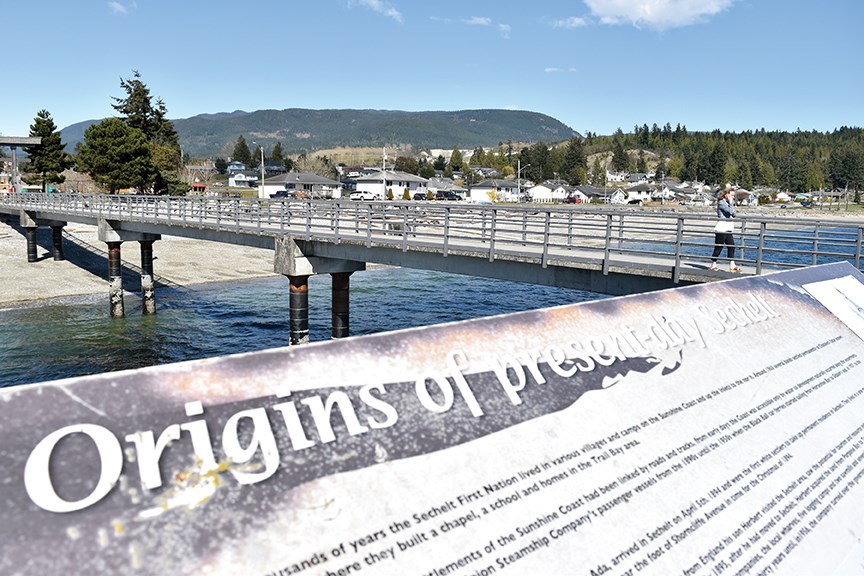A stretch of pebbled shoreline and a roadway flecked with chain link fence dividing shíshálh and District of Sechelt lands could become sites for the community and beyond to walk a few steps down the path of reconciliation.
The initiative, still in its infancy, is being planned by those involved with the syiyaya reconciliation movement, including newcomer and Salish Environmental Group founder Aaron Joe, who presented an idea for revitalizing the waterfront at the bay of ch’atlich or Trail Bay and removing chain link fencing along Xenichen Avenue at a District of Sechelt council meeting last week.
“I’ve been thinking about this for quite some time,” Joe told council on April 7, adding he had been searching for a way to contribute after being encouraged by his mother and shíshálh Nation elder Valerie Joe to join the movement.
“I’d like to be part of a movement that acknowledges our past but also demonstrates how we can move forward,” he said.
Joe shared elements of what he described as an “opportunity of a shared project on the waterfront,” including building a pavilion at the end of the pier at Friendship Park, installing lighting and upgrading the path along shíshálh Nation land.
An interpretive sign already located on the pier largely focuses on settler history. The group has suggested installing “shíshálh and settler historical information on the pier creating a gathering place on the water,” according to a letter submitted to council by former chief and syiyaya co-founder Garry Feschuk.
Friendship Park stands adjacent to shíshálh Nation land and was built by the Rotary Club of the Sunshine Coast–Sechelt, while the pier is operated by District of Sechelt.
The landmarks at the dividing line between shíshálh Nation and the District of Sechelt are conspicuous for anyone walking the shoreline from Selma Park to Snickett Park, known by some as “Rock to Rock,” especially now as the nation has kept its roads closed to non-members to protect the Indigenous community during the pandemic.
Additional interpretive “Rock to Rock” signage has been proposed along the shoreline of the bay of ch’atlich (Trail Bay).
Xenichen Avenue, which runs from Porpoise Bay through Sechelt and parallel to Friendship Park, also divides the two jurisdictions, with chain link fence obstructing some locations.
At the meeting, Joe said after sharing his idea with members of the syiyaya movement and with Sechelt Mayor Darnelda Siegers, “it seemed to make good sense that we start to look at taking some of the fences down on the border between the shíshálh Nation lands and the District of Sechelt.”
Removing the fencing has been a long-standing desire of some shíshálh Nation elders, syiyaya co-founder Nancy Denham told Coast Reporter after the meeting. “Elders suggested bringing down the wall years ago,” she said.
An art installation walkway project along the section of road from McDonald’s to Friendship Park, with artwork from shíshálh Nation and Sechelt artists, has been proposed.
“As this new initiative evolves, we envision many more ideas and projects will come forward,” said the letter.
The District of Sechelt has applied for a $7,500 “start-up” grant through the Sunshine Coast Foundation, and at the meeting council voted unanimously to support the multi-year project in principle.
Shíshálh Nation council was also expected to vote to support the project in principle at an April 14 meeting, after Coast Reporter’s print deadline.
Sechelt council also approved using $5,000 from the council contingency fund to assist with project management costs, including retaining Rebecca Klady and Brian Johnson to initiate community outreach and to apply for provincial and federal grants to cover costs once project ideas are finalized.
“We’re going to start very quickly now [and] try to talk to as many people as we can, try to identify different projects that can all be connected into some broader vision of moving forward in the right direction together,” said Johnson at the meeting.
“It will culminate towards the end of June with some grant applications, to see if we can’t move some of these projects forward.”
A steering committee has also been established, which includes Aaron Joe, former shíshálh Nation chief Calvin Craigan, Siegers and Denham.
The group will be seeking both grants and local contributions, said Johnson, and if grants are successful, the district would be reimbursed.
Garry Feschuk, who introduced the concept at the April 7 meeting, referenced Sechelt/shíshálh Hospital as another example of how the two jurisdictions have collaborated in the past.
The band donated 10 acres of land to move the hospital from Pender Harbour to its now central location in Sechelt.
“I’m really looking forward to having a proposal put into detail with the help of both the Sechelt Indian Band and the District of Sechelt, to have ideas to make that into a reality. It will be a showcase of how First Nations and outside communities can work together,” he said.
In his letter to council, Feschuk noted the syiyaya movement is also planning a ceremony for the survivors of residential school.
He said work must continue to help heal survivors of residential school, who inspired the movement in the first place following the release of the Truth and Reconciliation Commission of Canada’s 94 Calls to Action.
“Reconciliation is not an easy process,” said Feschuk. “I really think it may take a million steps before we get to full reconciliation, but we’re well on our way.”



